AI-Powered Nutrition Analyzer Key Market Takeaway- What Are AI Nutrition Apps?
- How Does An AI Analyze Food Nutrition?
- Benefits Of AI Nutrition Analyzers
- Development Considerations For AI-powered Nutrition Analyzer
- The Future Of AI Nutrition Analysis
- Must-Have Features In An AI-Powered Nutrition Analyzer App
- How To Develop An AI-Powered Nutrition Analyzer Platform?
- Top 5 AI-Powered Nutrition Analyzer Platforms In The Market Right Now
- Conclusion
- How Can We Help?
- FAQ

Nutrition plays a fundamental role in our overall health and well-being. From keeping our energy levels up to strengthening our immune system and reducing disease risk, the food we choose has a great impact on how we function.
However, keeping track of what we eat can be challenging. Traditional methods like food journals and calorie counting can take time and effort.
The difficulty of tracking food intake creates business opportunities for innovative solutions that simplify and personalize this process. Imagine mobile apps that use image recognition to automatically log meals or wearable devices that monitor blood sugar levels and recommend dietary adjustments.
This blog dives into the importance of nutrition and explores the challenges of traditional dietary assessment methods and considerations for developing great solutions.
AI-Powered Nutrition Analyzer Key Market Takeaway- What Are AI Nutrition Apps?
- How Does An AI Analyze Food Nutrition?
- Benefits Of AI Nutrition Analyzers
- Development Considerations For AI-powered Nutrition Analyzer
- The Future Of AI Nutrition Analysis
- Must-Have Features In An AI-Powered Nutrition Analyzer App
- How To Develop An AI-Powered Nutrition Analyzer Platform?
- Top 5 AI-Powered Nutrition Analyzer Platforms In The Market Right Now
- Conclusion
- How Can We Help?
- FAQ
AI-Powered Nutrition Analyzer Key Market Takeaway
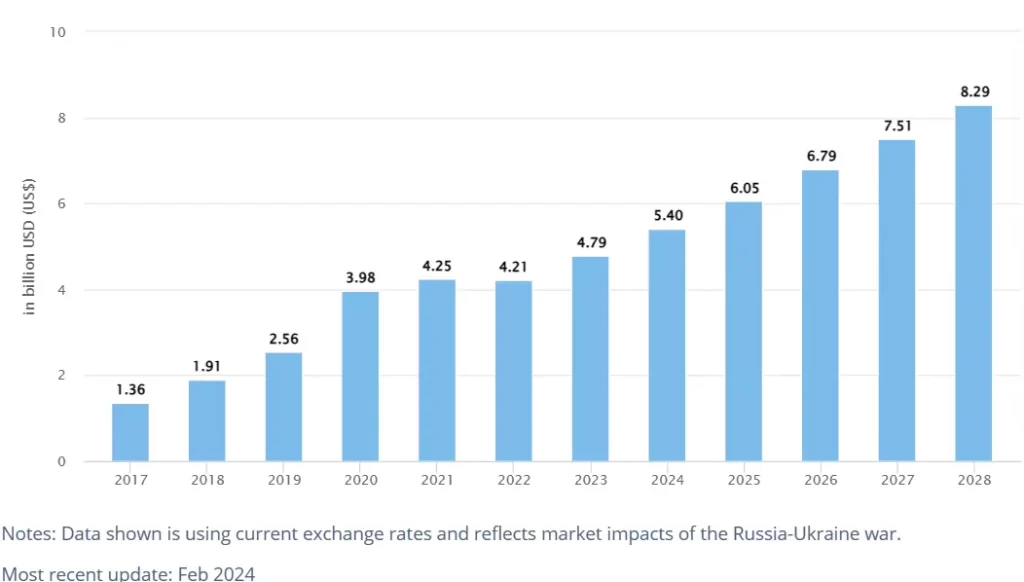
Source: Statista
Here are more stats indicating why it is a great time to invest in developing an AI-powered nutrition analyzer app
- An estimated 4.40% of the population will use nutrition apps in 2024, increasing to 5.15% by 2028.
- The average revenue per user (ARPU) is projected to be US$40.69.
- India is expected to lead the world in revenue generated by Nutrition Apps in 2024 at US$1.581 billion.
- Nutrition apps are gaining popularity worldwide, with countries like the US using digital health platforms to promote healthy eating.
What Are AI Nutrition Apps?
AI nutrition apps are revolutionizing how we track food intake and receive nutritional guidance. These apps allow users to simply take a picture of their meal to log it, eliminating the need for manual entry. Some apps go even further, featuring AI chatbots that answer nutritional questions in real-time.
For a truly personalized experience, certain apps connect with health organizations to access users’ medical data, allowing AI algorithms to generate customized recommendations. This technology can impact the field of dietetics and the way we approach nutrition care.
With AI constantly learning and evolving, these apps have the potential to become even more sophisticated, offering ongoing support and motivation on the journey to a healthier lifestyle.
How Does An AI Analyze Food Nutrition?
AI is revolutionizing how we understand and interact with food. Here’s a deeper dive into how AI analyzes food nutrition:
1. Image Recognition
Imagine snapping a picture of your lunch and instantly knowing its nutritional breakdown. AI with image recognition makes this possible. It utilizes deep learning, a form of machine learning inspired by the human brain’s structure and function. By analyzing vast amounts of food images labeled with their nutritional content, AI models can learn to identify and quantify different food items in your picture. This allows you to track calorie intake, identify allergens, and make informed dietary choices.
2. Text Recognition
Ever wished your restaurant menu or grocery receipt revealed the hidden nutritional details? AI with text recognition can bridge this gap. Natural Language Processing (NLP) empowers AI to understand the nuances of human language. It can analyze textual descriptions of meals, extracting relevant information like ingredients, portion sizes, and even preparation methods. Imagine scanning a menu and instantly seeing a breakdown of calories, carbs, and protein for each dish. NLP makes informed dining a breeze.
3. Combining Image and Text
The true magic unfolds when AI combines its image and text recognition process. Imagine uploading a picture of your homemade stir-fry along with the recipe. The AI, using image recognition, identifies the ingredients in your dish. Then, NLP analyzes the recipe to confirm quantities and cooking methods. By merging this data, the AI can provide a highly accurate nutritional analysis of your specific meal, taking into account variations and portion sizes. This empowers you to personalize your diet and optimize your health goals.
Benefits Of AI Nutrition Analyzers
AI nutrition analyzers are revolutionizing how we understand and track what we eat. These tools, powered by machine learning, offer a range of advantages for both businesses and users.
I. For Businesses
In today’s data-driven world, AI-powered nutrition analyzers offer businesses a powerful tool to enhance their products, improve customer targeting, and streamline operations.
- Enhanced Customer Engagement: Offer AI-powered nutritional analysis within your app or platform. This keeps users engaged and coming back for more, fostering brand loyalty.
- Personalized Nutrition Insights: AI can personalize recommendations based on user goals (weight loss, muscle gain, etc.) and dietary restrictions. This sets your business apart by providing a more holistic approach to health and wellness.
- Streamlined Data Collection: AI analyzers can automatically collect and analyze vast amounts of dietary data. This allows for a better understanding of customer preferences and the development of targeted marketing strategies.
- Improved Product Development: Analyze user data to identify trends and gaps in the market. This can inform the creation of new food products that cater to specific dietary needs.
II. For Users
Understand how this smart tech empowers users to make informed choices, optimize their diet, and unlock a healthier lifestyle.
- Effortless Diet Tracking: Take the guesswork out of tracking your intake. Simply snap a picture of your meal and let the AI analyzer do the work.
- Personalized Nutrition Goals: AI can analyze your diet and suggest adjustments to reach your specific goals, like weight management or building muscle.
- Greater Nutritional Awareness: Gain insights into the macronutrient (carbs, protein, fat) and micronutrient (vitamins, minerals) content of your meals. This empowers you to make informed dietary choices.
- Convenience and Time-Saving: No more manual logging or researching nutritional information. AI analyzers offer a quick and easy way to track your diet.
Development Considerations For AI-powered Nutrition Analyzer
AI-powered nutrition analyzers are revolutionizing how we track our food intake. But building one requires careful planning. This section explores key considerations for developers, from image recognition to personalized dietary insights, ensuring an accurate and user-friendly nutritional analysis tool.
1. Data Collection and Training
The foundation of an accurate AI-powered nutrition analyzer lies in its training data. A vast and diverse food image dataset is crucial. This dataset should encompass a wide variety of cuisines, ingredients, portion sizes, and preparation methods.
The more comprehensive the data, the better the AI model can recognize and differentiate food items in user-generated photos.
Here are some ways to collect data:
- Crowdsourcing platforms where users contribute labeled food images.
- Collaborations with restaurants and food businesses for access to professional food photography.
- Partnerships with stock photo agencies that specialize in high-quality food images.
2. Nutritional Database Integration
Once the AI model identifies food items in a user’s photo, it needs access to a comprehensive nutritional database, and the database should include detailed information on macronutrients (carbs, protein, fat), micronutrients (vitamins and minerals), and other relevant data points.
The database should account for variations based on cooking methods, processing, and origin (organic vs. conventional). Integrating with a reliable and up-to-date nutritional database ensures users receive accurate information about their dietary intake.
Here are some factors to consider when choosing a database:
- Scope and comprehensiveness of food entries.
- Transparency regarding data sources and methodology.
- Regular updates to reflect changes in nutritional information.
3. User Interface and User Experience Design
A user-friendly interface is paramount for encouraging consistent engagement with the AI nutrition analyzer. The design should be visually appealing, guiding users through the process of capturing food photos and receiving nutritional information. Consider these elements:
- Simplicity: A clean interface with clear instructions minimizes user confusion.
- Image Capture: Easy-to-use camera integration for seamless food photo capture.
- Progress Tracking: Visualize goals and dietary trends to keep users motivated.
- Personalization: Allow users to set dietary goals and receive tailored feedback.
- Actionable Insights: Provide clear and actionable insights based on nutritional analysis, like recipe suggestions or healthy alternatives.
The Future Of AI Nutrition Analysis
AI is revolutionizing how we understand and approach food. Here’s a glimpse into potential future advancements:
1. Integration with Wearable Health Trackers
Imagine a future where your AI nutrition app seamlessly connects with your fitness tracker. It wouldn’t just analyze your food intake but also consider your activity level, sleep patterns, and stress markers. This holistic view would allow for personalized recommendations that optimize your nutrition for your unique needs.
2. Personalized Recipe Recommendations
AI will move beyond simple calorie counting. By learning your dietary restrictions, allergies, and taste preferences, it can curate personalized recipe recommendations. Imagine having an AI that not only suggests meals that fit your macros but also considers your love for spicy food or your aversion to mushrooms.
3. Real-time Coaching and Motivational Support
AI coaches will become your constant companions on your health journey. By analyzing your dietary patterns and progress, they can offer real-time feedback and encouragement. The app can provide personalized talks and healthy recipe challenges to keep you engaged. This continuous support system can be a game-changer for those seeking long-term healthy eating habits.
Must-Have Features In An AI-Powered Nutrition Analyzer App
An AI-powered nutrition analyzer can be a powerful tool for anyone looking to make informed dietary choices. To be truly effective, such a system should possess several key features:
1. Image Recognition
The ability to analyze a picture of your meal and identify the individual ingredients is crucial. This allows for quick and effortless tracking of your nutritional intake.
2. Detailed Nutritional Breakdown
Once the food items are recognized, the analyzer should provide a comprehensive breakdown of their nutritional content. This includes macronutrients (carbs, protein, fat), micronutrients (vitamins, minerals), and other relevant details like calories, fiber, and sugar.
3. Goal Setting and Tracking
The analyzer should allow users to set personalized dietary goals, such as calorie intake or desired macronutrient ratios. By tracking your daily intake against these goals, you can gain valuable insights into your eating habits.
4. Personalized Recommendations
Ideally, the analyzer should leverage your goals and nutritional data to offer personalized recommendations. This could include suggestions for healthy recipe alternatives or adjustments to your current meals to reach your targets.
5. Dietary Restriction Support
The ability to meet specific dietary needs is a valuable asset. The analyzer should allow users to input dietary restrictions like gluten-free, vegan, or diabetic and adjust recommendations and analysis accordingly.
6. Ingredient-Level Analysis
For users with allergies or sensitivities, the option to analyze individual ingredients within a dish can be crucial. This allows for a more comprehensive understanding of potential triggers.
7. Meal Planning Integration
The analyzer can be even more powerful when integrated with meal-planning tools. Analyzing your current intake and goals can suggest recipes and create personalized meal plans that fit your needs.
8. Progress Tracking and Reports
Long-term health is key. The ability to track your progress over time through insightful reports can be highly motivating. Visualizing trends in your dietary choices allows for adjustments and celebrations of success.
9. Biometric Integration
For a truly holistic approach, some analyzers might integrate with wearable health trackers. By incorporating data like activity levels and weight, the system can provide more precise nutritional recommendations.
How To Develop An AI-Powered Nutrition Analyzer Platform?
Developing an app that analyzes nutrition with the power of AI requires careful planning and execution. Here’s a roadmap to guide you through the process:
1. Conception and Research
The journey begins with a spark of an idea! Identify the target users and their needs. Research current trends in nutrition and AI applications to understand the competitive landscape.
2. Defining Features and User Experience
Map out the app’s core functionalities based on user research. Design an intuitive and user-friendly interface that encourages engagement. Consider features like food image recognition, personalized dietary insights, and goal-setting tools.
3. Prototyping and Refinement
Create a basic, functional model of the app (prototype) to test user interaction and gather feedback. Refine the design based on user testing to ensure a smooth and intuitive experience.
4. Development and Integration
This stage involves building the app using programming languages and frameworks. Integrate key functionalities like AI models for food recognition and nutritional analysis. Connect to comprehensive nutritional databases for accurate data.
5. Personalization with Machine Learning
Implement machine learning algorithms to personalize the app experience. The AI can analyze user data like dietary habits and goals to provide customized recommendations and track progress over time.
6. Security and Compliance
Since the app handles sensitive health information, robust security measures are crucial. Implement data encryption and anonymization practices. Ensure compliance with relevant data privacy regulations.
7. Launch, Marketing, and Iteration
With a polished app, it’s time for launch! Develop a strategy to reach your target audience. Continuously gather user feedback and iterate on the app’s features and functionalities based on their needs.
Top 5 AI-Powered Nutrition Analyzer Platforms In The Market Right Now
In today’s busy world, maintaining a healthy diet can be challenging. AI-powered meal planning and nutrition apps can help you make informed choices and save time. Here are five options to consider:
1. MealMind

MealMind takes a scientific approach to meal planning. This app offers AI-generated meal plans that meet your specific dietary needs, preferences, and body goals. MealMind provides interactive shopping lists and step-by-step recipe instructions to enhance your cooking skills. While the most expensive option on this list at $7.5 per week, it caters to users seeking a data-driven approach to healthy eating.
2. MyMealPlanAI
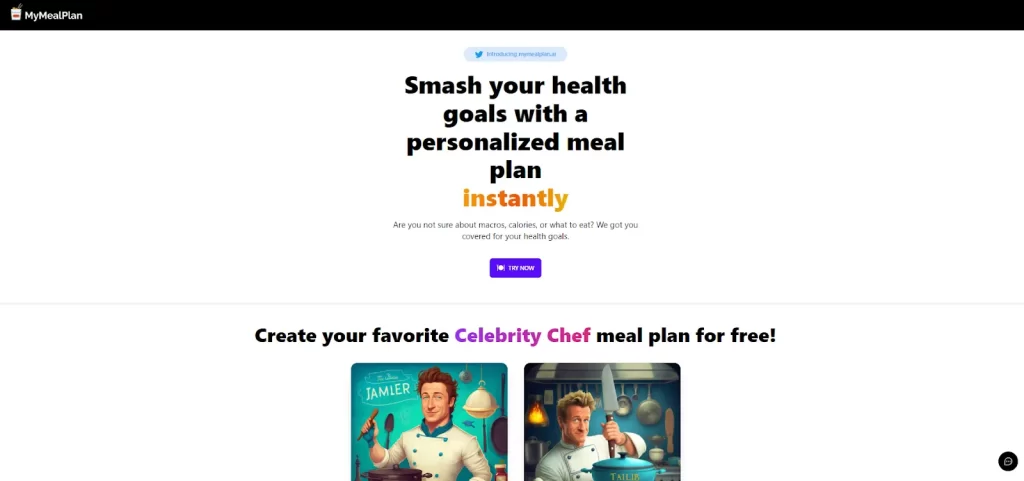
This free app creates customized meal plans based on your health goals, allergies, and dietary preferences. It even offers AI-generated meal plans from celebrity chefs like Jamie Oliver and Gordon Ramsay. MyMealPlanAI generates organized grocery lists to simplify your shopping experience.
3. MealPractice
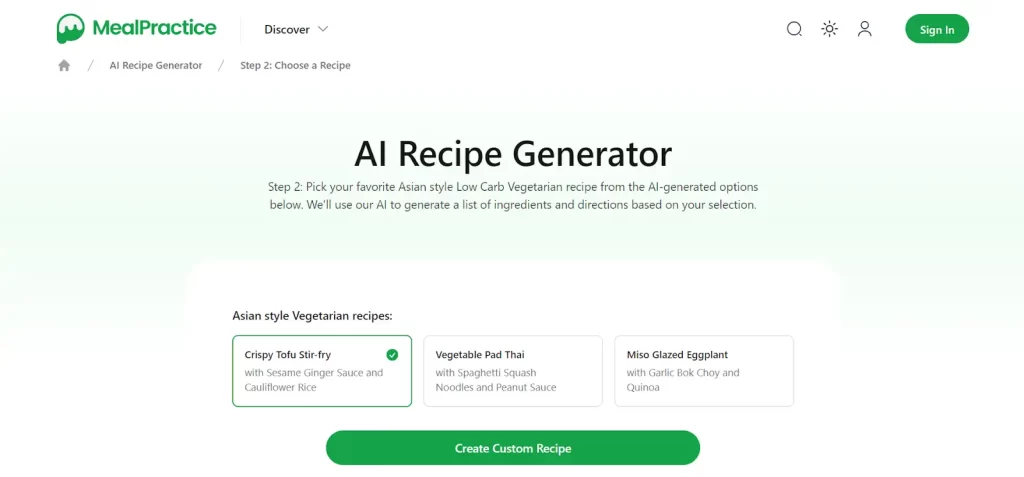
MealPractice offers a user-friendly interface for meal planning. Choose a protein, cuisine, and number of servings, and the app recommends top-rated recipes. You can create custom recipes, edit existing ones, and share them with others. Most features are currently free.
4. MikeAI
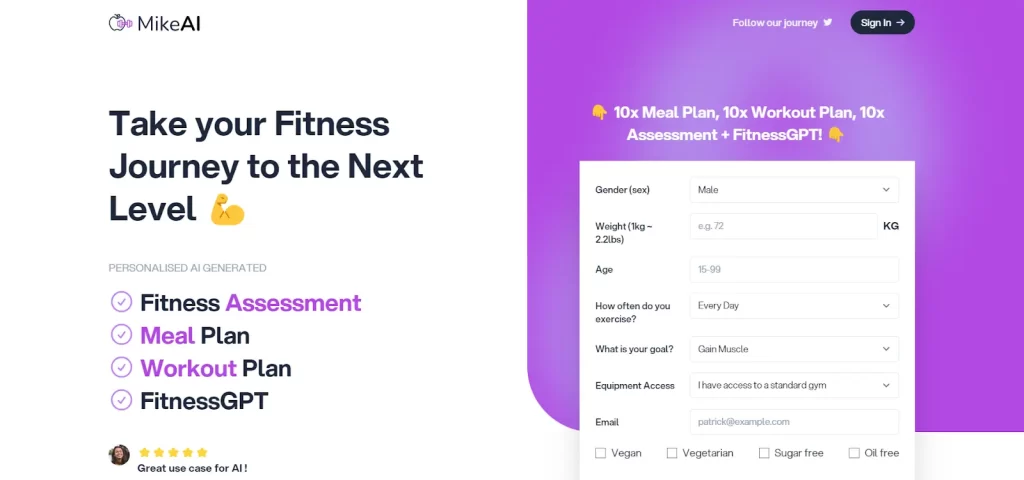
MikeAI goes beyond meal planning, acting as your AI gym buddy. It provides a personalized fitness assessment and custom meal plans tailored to your goals. MikeAI also generates workout plans and offers an interactive AI chatbot called FitnessGPT for ongoing support. For a one-time payment of $4.99, this app provides a comprehensive fitness and nutrition solution.
5. Meals.AI
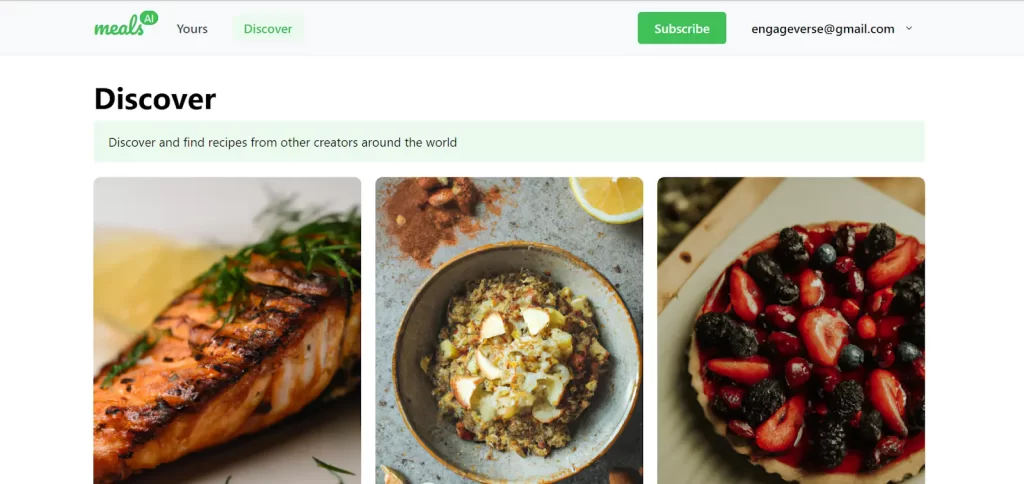
Meals.AI generates recipes based on your preferences and dietary needs. It provides stunning visuals for each recipe, helping you decide what to cook. You can specify meal preparation times and dietary restrictions and even create holiday-themed recipes. The free trial lets you explore,
Conclusion
AI-powered nutrition analyzers hold great potential for the future of personalized health, which can empower individuals to make informed choices about what they eat and align their diet with their specific health goals.
However, training AI models needs massive datasets of tagged food photos, and reliably identifying complicated cuisines or custom meals remains a challenge.
Collaboration with an app development business is very beneficial in this situation. Their knowledge bridges the gap between cutting-edge AI research and usable applications. They are equipped to handle the complexity of data collecting, model creation, and app integration.
How Can We Help?
As an app development company at the forefront of innovation, we can help you develop a next-generation AI-powered nutrition analyzer.
Imagine an app that empowers users to snap a picture of their meal simply. Our cutting-edge image recognition technology, powered by machine learning, can identify individual food items and their nutrition with stunning accuracy.
For more than ten years, we’ve been serving our development expertise and turning innovative concepts into thriving applications. We recognize the value of a reliable development partner, and you can witness our dedication to quality by exploring our portfolio.
You can explore the case study of a fitness app, RBT, to gain insight into our expertise in fitness apps and AI development.
Partner with us, and let’s revolutionize the way people approach nutrition and achieve their health goals.
FAQ
Q. How is AI used in nutrition?
A. Artificial intelligence is making waves in the world of nutrition. One way it’s used is through image recognition. AI-powered apps can analyze photos of your meals, identify ingredients, and estimate their nutritional content. This can be a huge time-saver for people tracking their macros or following specific diets.
Q. How can AI help with nutrition?
A. AI can also be a powerful tool for personalization. By analyzing your fitness goals, dietary restrictions, and past intake data, AI-powered assistants can suggest personalized meal plans and track your progress toward your goals. This can be especially helpful for people who are new to healthy eating or who have complex nutritional needs.
Q. What is the purpose of an AI-powered nutrition analyzer for fitness enthusiasts?
A. AI-powered nutrition analyzers aim to empower fitness enthusiasts with the information they need to make informed decisions about their diet.













Gaurav Patil